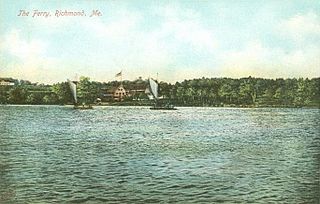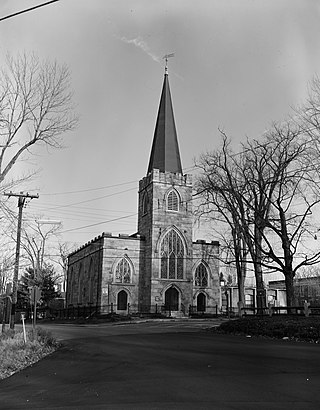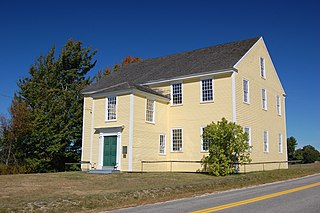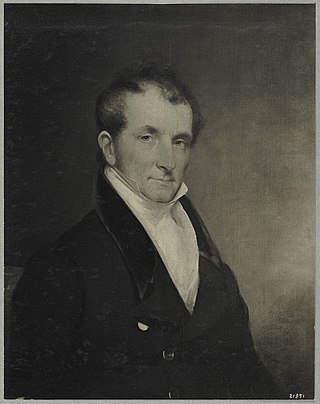
Gardiner is a city in Kennebec County, Maine, United States. The population was 5,961 at the 2020 census. Popular with tourists, Gardiner is noted for its culture and old architecture. Gardiner is a nationally accredited Main Street America community. It is included in the Augusta, Maine micropolitan New England City and Town Area.

Dresden is a town in Lincoln County, Maine, United States, that was incorporated in 1794. The population was 1,725 at the 2020 census.

Perkins Township is an unorganized territory in Sagadahoc County, Maine, United States. Originally incorporated as the town of Perkins, it was later abandoned, and has been uninhabited since the 1940s. The township comprises Swan Island, Little Swan Island and some tidal flats—all within the Kennebec River between the towns of Richmond and Dresden. The Swan Island Historic District comprises most of the township, with eight buildings, five structures and 1,500 acres (610 ha). Some of the buildings date to the 1750s. The district was added to the National Register of Historic Places in 1995. The entire township is now protected as the Steve Powell Wildlife Management Area, and is under the jurisdiction of the Maine Department of Inland Fisheries and Wildlife. Camping, hunting, fishing, and wildlife viewing are permitted between May and October; reservations are required.

Dr. Silvester Gardiner was a physician, pharmaceutical merchant and land developer of Maine. He is known for founding the city of Gardiner.

Jacob Bailey was an author and clergyman of the Church of England, active in New England and Nova Scotia.

Fort Halifax is a former British colonial outpost on the banks of the Sebasticook River, just above its mouth at the Kennebec River, in Winslow, Maine. Originally built as a wooden palisaded fort in 1754, during the French and Indian War, only a single blockhouse survives. The oldest blockhouse in the United States, it is preserved as Fort Halifax State Historic Site, and is open to the public in the warmer months. The fort guarded Wabanaki canoe routes that reached to the St. Lawrence and Penobscot Valleys via the Chaudière-Kennebec and Sebasticook-Souadabscook rivers. The blockhouse was declared a National Historic Landmark and added to the National Register of Historic Places in 1968.

Trinity Church, on Queen Anne Square in Newport, Rhode Island, is a historic parish church in the Episcopal Diocese of Rhode Island. Founded in 1698, it is the oldest Episcopal parish in the state. In the mid 18th century, the church was home to the largest Anglican congregation in New England.

The Cushnoc Archeological Site, also known as Cushnoc or Koussinoc or Coussinoc, is an archaeological site in Augusta, Maine that was the location of a 17th-century trading post operated by English colonists from Plymouth Colony in present-day Massachusetts. The trading post was built in 1628 and lies on the Kennebec River. The English primarily traded with bands of the Abenaki nation.

Christ Episcopal Church is a historic church located at 1 Dresden Avenue in Gardiner, Maine. Built in 1820 for the oldest congregation in the Episcopal Diocese of Maine. It is the oldest known example of ecclesiastical Gothic Revival architecture in New England, and was listed on the National Register of Historic Places in 1973.

The Universalist Unitarian Church is a historic church on Silver Street and Elm Street in Waterville, Maine in the United States. Built in 1832 for a Universalist congregation founded in 1826, it is a prominent local example of transitional Federal-Gothic Revival architecture. It was listed on the National Register of Historic Places in 1978.

The Alna Meetinghouse is a historic meeting house on Maine State Route 218 in Alna Center, Maine. Built in 1789, it is one of the oldest churches in the state, with a virtually intact interior. It was listed on the National Register of Historic Places in 1970.

The Pownalborough Courthouse is a historic court house at 23 Courthouse Road in Dresden, Maine, USA. Built in the early 1760s, it was the first county courthouse for Lincoln County, which was established in 1760. It is the only surviving courthouse in the state of Maine that was built during the colonial period, and is now a museum owned and operated by the Lincoln County Historical Society. It was listed on the National Register of Historic Places in 1970.

Robert Hallowell Gardiner was a prominent, educated land owner in Maine. He represented the union of two great early New England fortunes. He was the grandson of both Dr. Silvester Gardiner, the founder of Gardiner, Maine, and Benjamin Hallowell, the founder of Hallowell, Maine. He was also a trustee for the Gardiner Lyceum school. He was instrumental in the growth of the city of Gardiner.

New Ireland was a Crown colony of the Kingdom of Great Britain twice established in modern-day Maine after British forces captured the area during the American Revolutionary War and again during the War of 1812. The colony lasted four years during the Revolution, and eight months during the War of 1812. At the end of each war the British ceded the land to the United States under the terms of the Treaty of Paris and the Treaty of Ghent, respectively.

Robert Benjamin Lewis was an African and Native American author, best known for writing Light and Truth. He also was an entrepreneur, successfully marketing hair oil and other commodities, and also held three United States patents.

Farmingdale is a town in Kennebec County, Maine, United States. The population was 2,995 at the 2020 census. Farmingdale is included in the Augusta, Maine micropolitan New England City and Town Area.

The Dresden Brick School House is a historic school building on Maine State Route 128 in Dresden, Maine. Built in 1816, it is one of the oldest surviving brick district school buildings in the state. It is now a museum property, owned by the local historical society. It was listed on the National Register of Historic Places in 1986.

The Gardiner Historic District encompasses the historic 19th-century commercial heart of the city of Gardiner, Maine. Once a leading port and industrial center on the Kennebec River, Gardiner's Water Street downtown area retains the feel of its late 19th-century commercial success. It was listed on the National Register of Historic Places in 1980.

Oaklands, also known locally as Oaklands Castle, is a historic house on Oaklands Farm in southern Gardiner, Maine. The main house of this farm property is a stone Gothic Revival work from the early career of the noted 19th-century architect Richard Upjohn. It was listed on the National Register of Historic Places in 1973.

The Powers House is a historic house on West River Road in Sidney, Maine. Built about 1770, it is an important example of late Colonial architecture in the region. It was listed on the National Register of Historic Places in 1979.


















